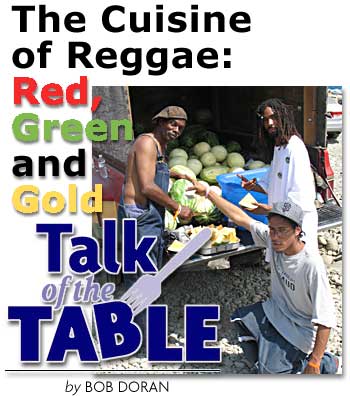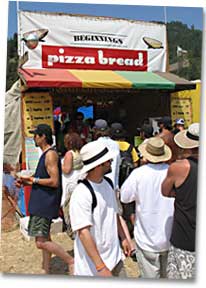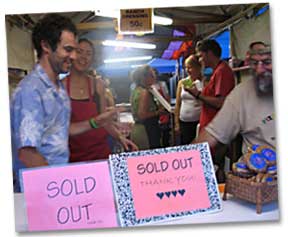|

COVER STORY | IN
THE NEWS | STAGE
MATTERS | DIRT
TALK OF THE TABLE | THE HUM | CALENDAR
August 10, 2006

They call it Bob Marley
Boulevard, the thoroughfare at Reggae on the River that goes
from the camping area at French's Camp to a bridge across the
Eel and on up to the new Reggae on the River festival entrance.
It's a rocky road lined with dusty cars, SUVs and tents. The
late night party people were just stirring late in the morning
as a stream of reggae revelers walked along it, headed toward
the music, making way for an occasional auto or off-road vehicle.
The Watermelon Man was parked along the boulevard,
the tailgate down on his red, green and gold painted pickup revealing
a cargo of luscious melons.
"Fresh, juicy, golden watermelons! Get your
delicious watermelon slices, just a dollar!" shouted a young
urban barker wearing a Giants cap and wire-rimmed glasses with
no lenses, and holding a fistful of bills.
The Watermelon Man, shirtless in a pair of farmer's
overalls and a weathered leather cap, expertly wielded a long
knife, filling an aluminum tray with golden triangles and slices
of honeydew melon. His dreadlocked son, the third in the operation,
worked the other side of the tailgate in his stylishly oversized
white T.
I bought a slice and, yes, it lived up to the juicy,
delicious patter. The Watermelon Man (I never did learn his real
name) explained that he grows the melons near Sacramento for
a seed company, so most of the year the fruit is processed, the
remains composted or turned into animal feed.
 As
he began to tell me about how he started growing melons 30 years
ago in an urban garden in San Francisco's Hunter's Point, spinning
a story about community building, a 4-wheeler rolled up, driven
by a guy in a yellow shirt from the Security crew. "Sorry,
no vending allowed on Bob Marley Boulevard", he announced
almost apologetically. "You'll have to pack up and move
this truck off this road," he insisted as the barker resisted.
Our conversation was cut short as the trio moved to comply. I
kept moving toward the music and the officially sanctioned food. As
he began to tell me about how he started growing melons 30 years
ago in an urban garden in San Francisco's Hunter's Point, spinning
a story about community building, a 4-wheeler rolled up, driven
by a guy in a yellow shirt from the Security crew. "Sorry,
no vending allowed on Bob Marley Boulevard", he announced
almost apologetically. "You'll have to pack up and move
this truck off this road," he insisted as the barker resisted.
Our conversation was cut short as the trio moved to comply. I
kept moving toward the music and the officially sanctioned food.
Right: Beginnings' pizza bread booth.
Reggae on the River has long been the ultimate
fund-raising opportunity for Humboldt nonprofits, mostly from
south county, but from up north and Mendocino too. Dozens of
schools, volunteer fire departments and assorted other community
groups set up shop and feed the crowd of around 15,000. Some
of the organizations derive the majority of their annual operating
budgets from the green and gold they earn at Reggae.
As you may have heard, the festival expanded upriver
this year with the center of operations moving to the larger,
cooler and lusher Dimmick Ranch. With Reggae 2.0 using a new
location for the concert grounds, organizers redesigned what
was once a straight restaurant row, bending it into a horseshoe
food court with booths facing outward, leaving a common area
in the middle and an open end for easy access.
Of course the old adage, location, location, location,
was in effect with more action on the side opposite the stage.
The Sprowel Creek VFD root beer/Coke float booth in the corner
furthest from the music didn't seem to have much business, but
then again, maybe people just weren't in the mood for floats,
or the $4 price seemed too high, or perhaps there was some fear
of high-fructose corn syrup.
For my purposes the most popular booths were at
a disadvantage. I usually wanted to eat between music sets (as
did everyone else) and the lines grew too long for an eager diner
in a hurry. Thus I never tried the Indian tacos made by the folks
from KuKsui, a cultural survival project based on the Round Valley
Indian Reservation. They piled the greasy but good fry bread
with beans, cheese, lettuce tomatoes and salsa, earning praise
from pleased customers (and some needed funds).
I sampled the potstickers from the Garberville
Town Square booth and found them slightly disappointing in that
they were just frozen prefab items, probably from Costco. The
samosas at the nearby Mattole Salmon Group booth were
much better, especially the vegetarian version filled with spicy
peas, carrots and potatoes, served with a garlicky dipping sauce.
The local Veterans for Peace (seen Fridays on the
Arcata Plaza) made their first foray to Reggae this year, selling
tasty chile rellenos and a fine carne asade made
from grass-fed beef served with a wedge of lime and excellent
salsa (or, for the vegans, carne seitan). I don't know
about others in the crowd, but I chose the place because I believe
in their cause. I had a Ben & Jerry's ice cream bar from
the peace-waging Garberville VFW Post No. 6354 for dessert, twice.
Sunday night when hunger struck I headed for the
Beginnings pizza bread booth only to find the typically long
line — same thing around the corner at the Trees Foundation's
Thai noodles booth. There was no line next door at the Brazilian
food place run by a SoHum Capoeira club. Signage may have made
the difference. The Tree's sign was huge and announced most of
the menu. The Capoeira booth suggested that the food was "organic"
and "vegan", neglecting to mention that a chicken dish
was also an option.
 Impatient,
I switched from the Thai line and tried the muquecha,
a Brazilian dish with onions, peppers and coconut milk (and chicken)
served with black beans and rice. It was just what I needed:
tasty and pretty filling. But I still wanted pesto pizza bread.
An unscientific poll over the weekend told me that it was the
best thing around — the ultimate Reggae food, according
to one long-time festival-goer. As I rounded the corner I thought
I was in luck: The line had mysteriously disappeared. Of course
there was a reason. The young crew was putting up a sign that
said, "Sold out, thank you." I stopped to ask how they'd
done, how much they may have made, and was referred to a supervising
elder, who turned out to be Beginnings Inc. director Peter Ryce.
He figured they'd sold 10,000 slices of pizza bread, which is
actually a slab of French bread topped with tomato sauce, cheese
and a choice of pineapple, sliced black olives, and/or Nona Lena
pesto. The mark-up is good: An order costs about $1 to make and
sells for $4.50 to $6. Impatient,
I switched from the Thai line and tried the muquecha,
a Brazilian dish with onions, peppers and coconut milk (and chicken)
served with black beans and rice. It was just what I needed:
tasty and pretty filling. But I still wanted pesto pizza bread.
An unscientific poll over the weekend told me that it was the
best thing around — the ultimate Reggae food, according
to one long-time festival-goer. As I rounded the corner I thought
I was in luck: The line had mysteriously disappeared. Of course
there was a reason. The young crew was putting up a sign that
said, "Sold out, thank you." I stopped to ask how they'd
done, how much they may have made, and was referred to a supervising
elder, who turned out to be Beginnings Inc. director Peter Ryce.
He figured they'd sold 10,000 slices of pizza bread, which is
actually a slab of French bread topped with tomato sauce, cheese
and a choice of pineapple, sliced black olives, and/or Nona Lena
pesto. The mark-up is good: An order costs about $1 to make and
sells for $4.50 to $6.
"It's labor intensive — hard work,"
said Peter, noting that he enjoys the community aspect of the
labor. Students, parents and returning former students run the
booth.
The net profit, probably around $20,000, will help
support Skyfish School and Children's House (the Montessori preschool
that was the beginning of Beginnings) along with two fire departments
in the Briceland area. Specifically, this years' money will go
toward upgrading and expanding the kitchen in the Octagon, the
central Beginnings structure, which also serves as Briceland's
community center. If you read the Journal calendar regularly
you'll see that events at the Octagon invariably begin with a
dinner of some sort. "We're overdue for some new equipment,"
said Peter.
What makes their pizza bread the ultimate Reggae
food item? Peter thinks it's simple. "They're red, green,
gold and black reggae colors," he said with a smile, and
returned to the task at hand, counting the weekend green.
As always, there's more to the story. I didn't
get around to Paul and Margann's fine wine potluck or my search
for the amazing underground soul food kitchen. For more photos
and stories on Reggae Cuisine go to www.flickr.com/photos/humblog.

your
Talk of the Table comments, recipes and ideas to Bob Doran.
COVER STORY | IN
THE NEWS | STAGE
MATTERS | DIRT
TALK OF THE TABLE | THE HUM | CALENDAR
Comments? Write a
letter!

© Copyright 2006, North Coast Journal,
Inc.
|